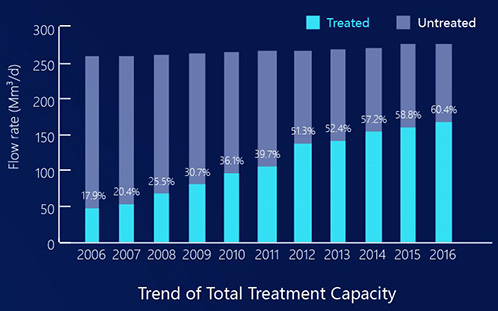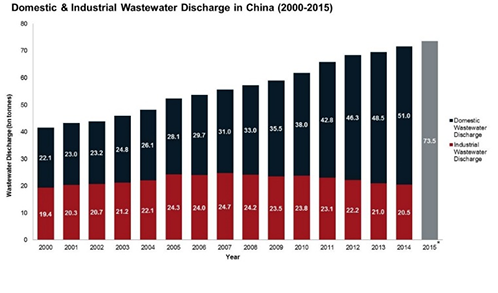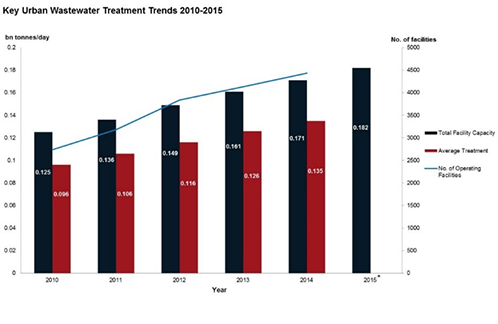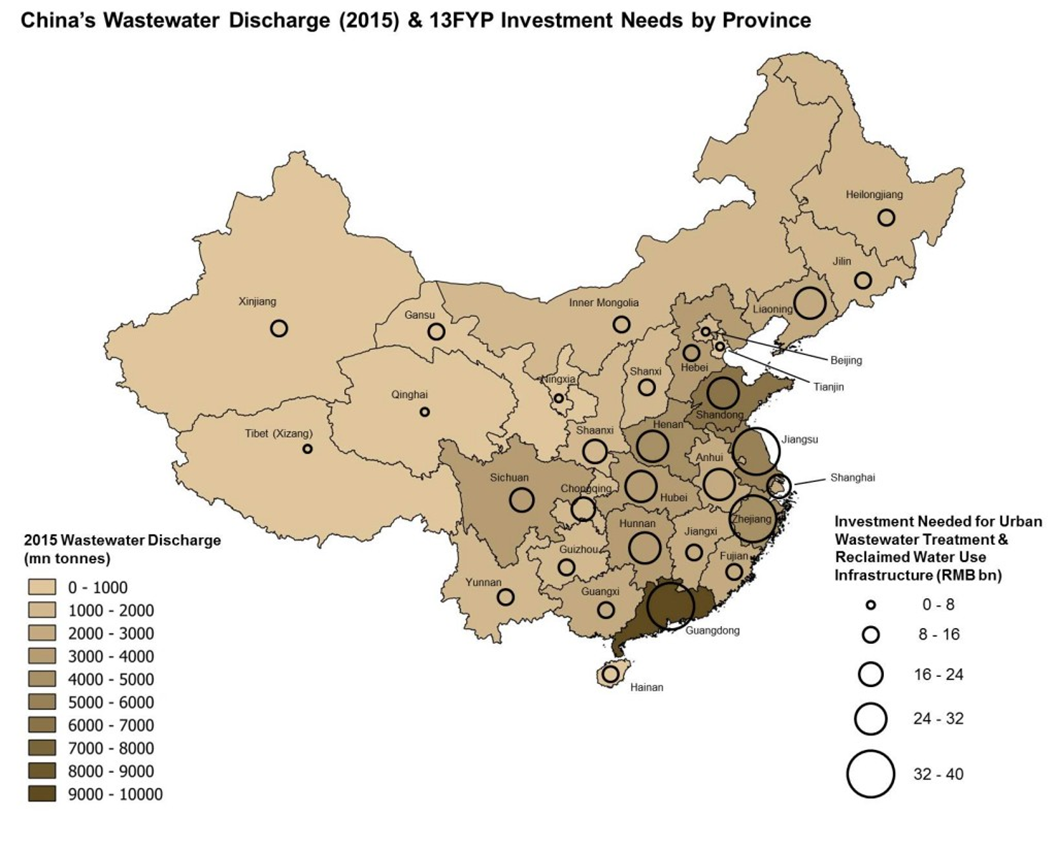Opportunities for Investors

China places a high amount of importance on maintaining clean water for municipal use and the environment, which is why the Chinese government is expending an additional RMB 4 trillion to upgrade its water systems. As foreign investors can bring a wealth of experience and new technologies, their involvement is not only necessary for water conservancy, environmental management, and public facility maintenance, but also for advances in wastewater treatment technology. Additionally, foreign investors can contribute to the development of innovative urban water designs and energy-efficient water-saving technologies, secondary water supply systems, smart water systems, environmentally friendly rainwater collecting, water purification, municipal pipe networks, and water reclamation technology.
In addition to treatment technologies, water infrastructure is an essential part of the industry. Creative urban water design and energy-saving water-saving techniques, secondary water supply systems, innovative water systems, eco-friendly rainwater harvesting, water purification, municipal piping systems, and water reclamation technology are all supplementary components that are available for foreign investment.
The undeniable reality is that it is cheaper to contaminate than to purify. This is due to systemic problems with wastewater costing and release criteria. Thus, despite a vast number of recorded pollution infringements, companies will still keep on polluting not just due to the fact that the punishments for polluting are still relatively low, but since it is currently more cost-effective to discharge untreated wastewater than to install and employ wastewater treatment equipment. Inadequate wastewater pricing also implies that some wastewater treatment plants are operating at a deficit. Just a few years ago, a quarter of wastewater treatment plants operated at a financial loss and had to rely on government support.
The population has grown and urban development has accelerated, resulting in increased global wastewater discharge, reaching between 260-450 billion tonnes yearly – similar to the amount of water in the Pearl River every year (340 billion tonnes). China's wastewater discharge has risen steadily over the past years. For example, in 2015 the total was 73.5 billion tonnes, which is almost double the reservoir capacity (39.3 billion tonnes) of the Three Gorges Dam, the biggest dam in the world.
No such thing exists as wastewater; it is simply water that is not utilized effectively.
Rather than viewing wastewater as a nuisance, we should consider it a resource. With the right treatment and reuse, wastewater can be an accessible and sustainable source of water, energy, and nutrients. For example, treated wastewater can be used to irrigate agricultural land and bolster food security. Currently, most of the wastewater generated worldwide is not treated or reused, with a global average of 80%. In high-income countries, about 70% of wastewater is treated, in contrast to just 8% in low-income countries. By 2030, the United Nations Sustainable Development Goal (SDG) demands that we cut in half the amount of untreated wastewater and greatly expand the worldwide recycling and safe reuse of it.
 Preserving energy and curtailing emissions are significant international concerns. Recently, 188 countries promised to diminish their emissions of greenhouse gases as part of an innovative agreement recognized on a large scale.
Despite the fact that China's wastewater treatment industry holds only a modest portion of the total reduction goal of global carbon emissions, it is a high-consumption sector that is growing fast and thus offers plentiful energy savings chances. A new report determined that through the utilization of existing advanced technologies, China's wastewater treatment industry has the potential to reduce direct and indirect CO2e (carbon dioxide equivalent) emissions by 15.7 million tons.
Preserving energy and curtailing emissions are significant international concerns. Recently, 188 countries promised to diminish their emissions of greenhouse gases as part of an innovative agreement recognized on a large scale.
Despite the fact that China's wastewater treatment industry holds only a modest portion of the total reduction goal of global carbon emissions, it is a high-consumption sector that is growing fast and thus offers plentiful energy savings chances. A new report determined that through the utilization of existing advanced technologies, China's wastewater treatment industry has the potential to reduce direct and indirect CO2e (carbon dioxide equivalent) emissions by 15.7 million tons.
The research highlights two main avenues for cutting down on pollution in China's wastewater treatment sector: one being decreasing emissions through technological advancement and the other being reducing emissions through improved processes.
- Replacing old electromechanical apparatus with energy-efficient equipment has the potential to reduce indirect carbon dioxide equivalent (CO2e) emissions by up to 5.1 million tonnes. Numerous highly efficient technologies, such as wastewater pumping, plug and flow mixing, aeration, and sludge treatment, exist which can generate more than 5 million tonnes of CO2e emission savings from the collection to processing and disposal of wastewater.
- ⦁ The implementation of energy recovery technologies could lead to a decrease of up to 10.6 million tonnes of both direct and indirect CO2e emissions. Through the advanced treatment of wastewater sludge, the direct CO2e emissions can be lowered by over 7 million tonnes. Additionally, the energy recovered from this treatment can be used to power current electromechanical devices, resulting in 3.5 million tonnes of indirect CO2e emissions being reduced.

The industry must take action to promote the widespread implementation of approaches that offer significant possibilities for reducing both direct and indirect carbon emissions.
It is essential that investment and construction choices be made according to life-cycle cost instead of just the lowest bid price. Even though these solutions might demand a greater initial capital investment, those with the smallest total life-cycle cost are more economically sound and often create the smallest energy utilization and indirect CO2e discharges.
The industry should set out emission decrease objectives, as well as a consistent carbon audit method. These regularized rules – which have been effectively executed in different areas – can give the framework required for financiers and utilities to make bigger investments in emission-decreasing technologies.

It is essential to bear in mind that China's wastewater treatment sector is not the only one to encounter such possibilities and issues. On a global scale, there is a great chance for this industry to reduce its energy-related emissions by up to half by using available and highly efficient technologies. By doing this, the industry has the potential to save close to $40 billion in energy costs, demonstrating that climate change can be a financially self-sustaining policy.
China witnessed a marked increase in wastewater treatment, with the capacity of urban wastewater treatment facilities increasing by 46% to 182 million tonnes and over 1,600 new facilities being established. This demonstrates that China has taken significant strides in its efforts to develop sustainable wastewater resources.

The map below indicates that Guangdong, Jiangsu and Zhejiang require the most investment in wastewater treatment, due to the greatest levels of discharge.

The Chinese government is actively exploring ways to fund wastewater projects. It is suggested to utilize the Public-Private-Partnership (PPP) model, which involves cooperation between the public and private sectors, and has already seen significant investments. The Ministry of Finance has even declared that all new wastewater projects should follow the PPP model. Additionally, China is aiming to repurpose industrial wastewater, which currently accounts for 23% of reclaimed water. Therefore, it is evident that China is committed to making use of its urban and industrial wastewater resources.
Experts suggest that reclaimed water should be prioritized in situations where the quality of the water is not critical, particularly in the industrial, irrigation, and dyeing sectors. Chinese policies are actively advocating the use of the Public-Private-Partnership (PPP) model, especially for water-related projects. It is considered that PPP should be employed in new waste and wastewater treatment projects. PPP has already been extensively utilized in such projects, demonstrating the government’s support for this method. PPP is a long-term collaboration between the public sector and private investors for infrastructure and public services, in which the former is responsible for regulating the pricing and quality of the projects, and the latter for design, construction, operation, and maintenance.
Water is an essential part of the infrastructure and public service, thus forming a close bond with Public-Private Partnerships (PPP). Aside from wastewater treatment, water supply, water pollution control and hydro-power, sponge cities and drainage networks may also offer potential areas for PPP investment.
Established by the Ministry of Finance, the China Public Private Partnerships Center (CPPPC) serves as a platform for policy research, information, and communication. It has two main purposes:
- Management platform: where financial administrations of the Chinese government are able to apply, review and analyze PPP projects;
- Information platform: where PPP policies, related information and case studies are published.